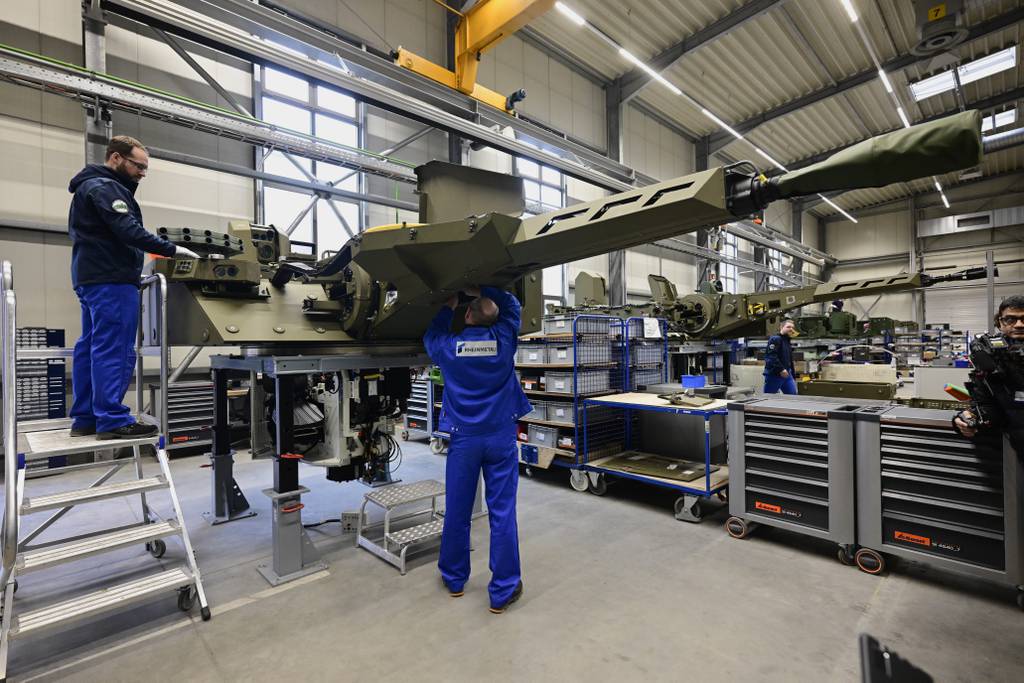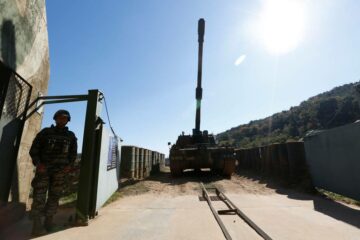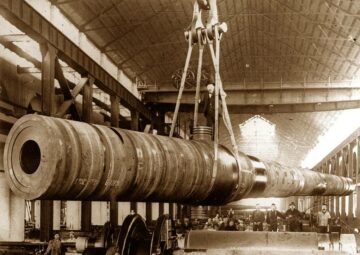
PARIS — The European Union’s executive branch has proposed a €1.5 billion (U.S. $1.6 billion) plan to boost defense production by promoting joint military purchases among the member states.
The European Commission on Tuesday presented its European Defence Industry Program aimed at bolstering a sector that has struggled to ramp up production in the face Russia’s full-scale invasion of Ukraine, which began in February 2022.
“The war is at our borders,” Josep Borrell, the EU’s high representative for foreign affairs and security policy, said during a news conference in Brussels on Tuesday. “Russia’s war of aggression has brought a great sense of urgency to step up our industrial defense capacities.”
With each of the EU’s 27 member states in charge of its defense budget, economic nationalism has often pushed countries such as France and Germany to buy local rather than European. The resulting fragmentation has a price: A European Parliament report in 2019 found the costs of duplication in security and defense policy among the bloc are at least €22 billion a year.
“In the last two years, we have faced the situation of a defense industry without sufficient production capacity to meet the sharp increase of demand,” the European Commission’s executive vice president, Margrethe Vestager, said at the news conference. “We have been vividly confronted with a well-known structural fragmentation along national borders that limits economies of scale, and creates mistrust, while preventing genuine competition between industrial players. This entails major inefficiencies, and insufficient value for taxpayer’s money.”
Funding for the European Defence Industry Program, or EDIP, runs from 2025 to 2027 and serves a bridge until the bloc negotiates a new long-term budget, said Thierry Breton, the EU commissioner for the internal market.
The commission suggested profits generated by frozen Russian assets could be used to fund support for Ukraine within the framework of EDIP, subject to a decision by the European Council. EU leaders meet in the council, which, together with the European Parliament, adopts European legislation.
The program would extend a regulation to incentivize joint procurement by member states in the EU’s defense industry, offering aid from the common budget to partially reimburse joint purchases. The commission also proposed continued financial support to boost Europe’s defense-industrial capacity.
The plan called for a new legal framework for joint European armament programs that includes favorable access to funding, simplified rules and potential waivers of value-added tax. Under the proposed plan, Ukraine would be able to participate in common procurement efforts.
The commission is inviting member states to spend at least 50% of their defense procurement budgets in the EU by 2030, and 60% by 2035. The union’s executive arm is also asking countries to collaboratively buy at least 40% of defense equipment by 2030.
From February 2022 to June 2023, EU states spent more than €100 billion on defense acquisitions, according to Vestager, who said almost 80% was spent outside the EU, with the U.S. alone accounting for more than 60%. She said spending that sort of money outside the bloc is no longer sustainable.
She added that while the EDIP budget “is not a lot of money” when it comes to defense, the funds can work as an incentive to bring together member states.
“The real funding for a stronger defense comes from member states, and that funding will increase over the years to come,” Vestager said. “What we can do here is to enable that funding to be spent in a better way, that we get more value for money, and that more, relatively speaking, is being spent in Europe.”
Another proposal is for a fund to fix supply chain bottlenecks in the EU’s defense industry, focused particularly on helping small and medium-sized companies with debt and equity financing. The commission plans to ask the governance bodies of the European Investment Bank to this year review lending policies, which currently limit defense investments to dual-purpose activities.
The commission proposed the creation of a defense-industrial readiness board that would be a forum for EU member states, and for the commission itself to define EU-level priorities to coordinate and smooth out countries’ procurement plans.
EDIP also includes measures to allow priority purchasing of civilian and military equipment in case the European Council declares a supply or security crisis, according to Breton. The council shot down a similar measure included in last year’s commission plan to boost EU ammunition production, and Breton said he hopes “this time it will pass.”
Breton added that the commission has developed plans to finance industrial sites that are ready to ramp up arms production if necessary, with EU funding to share the risk with industry.
The European ammunition industry increased production capacity by 50% since the start of the war in Ukraine, according to Borrell.
Breton said the EU is currently providing a little more than 80,000 artillery shells a month to Ukraine.
Borrell added that in addition to EU donations, Ukraine has purchased more than 350,000 shells from the European defense industry through direct contracts.
What matters now is that the EU defense-industrial base grows rapidly so Russian President Vladimir Putin understands “we are extremely serious,” Breton said.
He added that European defense production will not only match that of Russia — “we will do it much better.”
Rudy Ruitenberg is a Europe correspondent for Defense News. He started his career at Bloomberg News and has experience reporting on technology, commodity markets and politics.
- SEO Powered Content & PR Distribution. Get Amplified Today.
- PlatoData.Network Vertical Generative Ai. Empower Yourself. Access Here.
- PlatoAiStream. Web3 Intelligence. Knowledge Amplified. Access Here.
- PlatoESG. Carbon, CleanTech, Energy, Environment, Solar, Waste Management. Access Here.
- PlatoHealth. Biotech and Clinical Trials Intelligence. Access Here.
- Source: https://www.defensenews.com/global/europe/2024/03/05/eu-proposes-16-billion-plan-to-prop-up-defense-industry/
- :has
- :is
- :not
- $UP
- 000
- 2019
- 2022
- 2023
- 2025
- 2030
- 2035
- 27
- 350
- 5
- 6
- 70
- 8
- 80
- a
- Able
- access
- According
- Accounting
- acquisitions
- activities
- added
- addition
- Affairs
- Aid
- aimed
- allow
- almost
- along
- also
- ammunition
- among
- an
- and
- ARE
- ARM
- arms
- AS
- ask
- asking
- Assets
- At
- Bank
- base
- BE
- been
- began
- being
- Better
- between
- Billion
- bloc
- Bloomberg
- board
- bodies
- bolstering
- boost
- borders
- bottlenecks
- Branch
- BRIDGE
- bring
- brought
- Brussels
- budget
- Budgets
- buy
- by
- called
- CAN
- capacities
- Capacity
- Career
- case
- chain
- charge
- civilian
- come
- comes
- commission
- commissioner
- commodity
- Common
- Companies
- competition
- Conference
- continued
- contracts
- coordinate
- Costs
- could
- Council
- countries
- creates
- creation
- crisis
- Currently
- Debt
- decision
- declares
- defence
- Defense
- define
- Demand
- developed
- direct
- do
- donations
- down
- during
- each
- Economic
- economies
- Economies of Scale
- efforts
- enable
- entails
- equipment
- equity
- equity financing
- EU
- Europa
- Europe
- European
- european commission
- European Parliament
- Europes
- executive
- experience
- extend
- extremely
- Face
- faced
- favorable
- February
- finance
- financial
- financing
- Fix
- focused
- For
- foreign
- Forum
- found
- fragmentation
- Framework
- France
- from
- frozen
- full-scale
- fund
- funding
- funds
- generated
- genuine
- Germany
- get
- governance
- great
- Grows
- Have
- he
- helping
- here
- High
- his
- hopes
- HTTPS
- if
- images
- in
- Incentive
- incentivize
- included
- includes
- Increase
- increased
- industrial
- industry
- inefficiencies
- insufficient
- internal
- invasion
- investment
- Investments
- inviting
- IT
- ITS
- itself
- joint
- jpg
- june
- Last
- leaders
- least
- Legal
- legal framework
- Legislation
- lending
- LIMIT
- limits
- little
- local
- long-term
- longer
- Lot
- major
- Margrethe Vestager
- Market
- Markets
- Match
- Matters
- measure
- measures
- Meet
- member
- Military
- mistrust
- money
- Month
- more
- much
- National
- necessary
- New
- news
- no
- now
- of
- offering
- often
- on
- only
- or
- our
- out
- outside
- over
- parliament
- participate
- particularly
- pass
- plan
- plans
- plato
- Plato Data Intelligence
- PlatoData
- players
- policies
- policy
- politics
- potential
- presented
- president
- preventing
- price
- priority
- procurement
- Production
- profits
- Program
- Programs
- promoting
- proposal
- proposed
- proposes
- providing
- purchased
- purchases
- purchasing
- pushed
- Putin
- Ramp
- rapidly
- rather
- Readiness
- ready
- real
- Regulation
- relatively
- Reporting
- representative
- resulting
- review
- Risk
- rules
- runs
- Russia
- russian
- Russian president
- Russian President Vladimir Putin
- s
- Said
- Scale
- sector
- security
- sense
- Sense of Urgency
- serious
- serves
- sharp
- she
- shot
- similar
- simplified
- since
- Sites
- situation
- small
- smooth
- So
- sort
- speaking
- spend
- Spending
- spent
- start
- started
- States
- Step
- stronger
- structural
- subject
- such
- sufficient
- supply
- supply chain
- support
- sustainable
- tax
- Technology
- than
- that
- The
- their
- thierry breton
- this
- this year
- Through
- time
- to
- together
- Tuesday
- two
- u.s.
- Ukraine
- under
- understands
- until
- urgency
- used
- value
- vice
- Vice President
- Vladimir Putin
- war
- War in Ukraine
- was
- Way..
- we
- well-known
- when
- which
- while
- WHO
- will
- with
- within
- without
- Work
- would
- year
- years
- zephyrnet












